 W
WA lens mount is an interface – mechanical and often also electrical – between a photographic camera body and a lens. It is a feature of camera systems where the body allows interchangeable lenses, most usually the rangefinder camera, single lens reflex type, single lens mirrorless type or any movie camera of 16 mm or higher gauge. Lens mounts are also used to connect optical components in instrumentation that may not involve a camera, such as the modular components used in optical laboratory prototyping which join via C-mount or T-mount elements.
 W
WThe Minolta RD-175 was probably the first digital SLR which was hand portable. Up until 1995 when this was introduced, the only digital SLR on the market had a very bulky external digital storage system. There were other primitive digital cameras but they were much lower resolution. Minolta combined an existing SLR with a three way splitter and three separate CCD image sensors, giving 1.75M pixel resolution. The base of the DSLR was the Minolta Maxxum 500si Super. Agfa produced a version of the RD-175 retailed as the Agfa ActionCam.
 W
WThe Konica AR camera lens mount was introduced in 1965 with the Konica Autoreflex, together with a range of lenses. It features a comparably short flange focal distance of 40.50 mm for a 35 mm film SLR camera. Its diameter is 47 mm. The focus of the Konica Hexanon lenses were from 21 mm to 1000 mm; at the start one zoom 47-100mm f3.5 Hexanon AR-H was offered. Konica produced cameras for Konica AR bayonet until 1988.
 W
WA C mount is a type of lens mount commonly found on 16 mm movie cameras, closed-circuit television cameras, machine vision cameras and microscope phototubes.
 W
WThe EF lens mount is the standard lens mount on the Canon EOS family of SLR film and digital cameras. EF stands for "Electro-Focus": automatic focusing on EF lenses is handled by a dedicated electric motor built into the lens. Mechanically, it is a bayonet-style mount, and all communication between camera and lens takes place through electrical contacts; there are no mechanical levers or plungers. The mount was first introduced in 1987.
 W
WThe Canon EF-M lens mount, introduced in 2012, is a derivative of the Canon EF lens mount designed for use with the Canon EOS M mirrorless interchangeable-lens camera. The EF-M lens mount is one of Canon's two new systems for mirrorless cameras, the other being the RF mount.
 W
WThe Canon EF-S lens mount is a derivative of the EF lens mount created for a subset of Canon digital single-lens reflex cameras with APS-C sized image sensors. It was released in 2003. Cameras with the EF-S mount are backward compatible with the EF lenses and, as such, have a flange focal distance of 44.0 mm. Such cameras, however, have more clearance, allowing lens elements to be closer to the sensor than in the EF mount. Only Canon cameras released after 2003 with APS-C sized sensors support the EF-S mount.
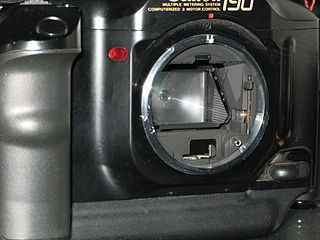 W
WThe Canon FD lens mount is a physical standard for connecting a photographic lens to a 35mm single-lens reflex camera body. The standard was developed by Canon of Japan and was introduced in March 1971 with the Canon F-1 camera. It served as the Canon SLR interchangeable lens mounting system until the 1987 introduction of the Canon EOS series cameras, which use the newer EF lens mount. The FD mount lingered through the release of the 1990 Canon T60, the last camera introduced in the FD system, and the end of the Canon New F-1 product cycle in 1992.
 W
WCanon FL refers to a lens mount standard for 35mm single-lens reflex cameras from Canon. It was introduced in April 1964 with the Canon FX camera, replacing the previous Canon R lens mount. The FL mount was in turn replaced in 1971 by the Canon FD lens mount. FL lenses can also be used on FD-mount cameras.
 W
WThe Canon R lens mount is a physical standard for connecting a camera lens to a 35mm single-lens reflex camera body. It was introduced in March 1959 along with the Canon Canonflex.
 W
WThe Canon RF lens mount is an interchangeable-lens mount developed by Canon for its full-frame mirrorless interchangeable-lens cameras, and featured first by the EOS R, followed by the EOS RP. The RF mount was announced in September 2018.
 W
WSony α, is a camera system introduced on 5 June 2006. It uses and expands upon Konica Minolta camera technologies, including the Minolta AF SLR lens mount, whose assets were acquired by Sony after the end of Konica Minolta's photography operations in early 2006. Sony also has an 11.08% ownership stake in Japanese lens manufacturer Tamron, which is known to have partnered with Konica Minolta and Sony in the design and manufacture of many zoom lenses.
 W
WThe E-mount is a lens mount designed by Sony for their NEX and ILCE series of camcorders and mirrorless cameras. The E-mount supplements Sony's A-mount, allowing the company to develop more compact imaging devices while maintaining compatibility with 35mm sensors. E-mount achieves this by:Minimizing mechanical complexity, removing mechanical aperture and focus drive. Shortening the flange focal distance to 18 mm compared with earlier offerings from Sony which used 44.5 mm. Reducing the radius of the flange.
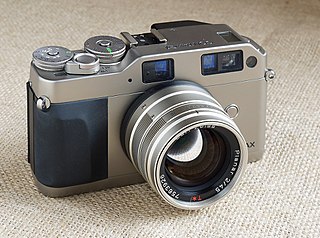 W
WThe Contax G camera line consists of two cameras, the G1 and G2, interchangeable-lens cameras sold by Kyocera under the Contax brand in competition with the Leica M7, Cosina Voigtländer Bessa-R, and Konica Hexar RF. The G1 was introduced in 1994 with the G2 joining it in 1996. In 2005, Kyocera retreated from the camera business and announced it would cease all activity related to the manufacture of Contax cameras at the end of the year, effectively spelling the end of the G system.
 W
WA C mount is a type of lens mount commonly found on 16 mm movie cameras, closed-circuit television cameras, machine vision cameras and microscope phototubes.
 W
WA D-mount is a type of lens mount commonly found on 8mm movie cameras.
 W
WThe Four Thirds System is a standard created by Olympus and Eastman Kodak for digital single-lens reflex camera (DSLR) and mirrorless camera design and development.
 W
WThe Nikon F-mount is a type of interchangeable lens mount developed by Nikon for its 35mm format single-lens reflex cameras. The F-mount was first introduced on the Nikon F camera in 1958, and features a three-lug bayonet mount with a 44 mm throat and a flange to focal plane distance of 46.5 mm. The company continues, with the 2020 D6 model, to use variations of the same lens mount specification for its film and digital SLR cameras.
 W
WThe Fujifilm G-mount is a type of interchangeable lens mount designed by Fujifilm for use in the cameras of their Fujifilm GFX series. These cameras have interchangeable lenses. The respective lenses are designed for 43.8 mm x 32.9 mm medium format sensors.
 W
WThe Fujifilm X-mount is a type of interchangeable lens mount designed by Fujifilm for use in those cameras in their X-series line that have interchangeable-lenses. These lenses are designed for 23.6mm x 15.6mm APS-C sensors.
 W
WCineAlta cameras are a series of professional digital movie cameras produced by Sony that replicate many of the same features of 35mm film motion picture cameras.
 W
WSony α, is a camera system introduced on 5 June 2006. It uses and expands upon Konica Minolta camera technologies, including the Minolta AF SLR lens mount, whose assets were acquired by Sony after the end of Konica Minolta's photography operations in early 2006. Sony also has an 11.08% ownership stake in Japanese lens manufacturer Tamron, which is known to have partnered with Konica Minolta and Sony in the design and manufacture of many zoom lenses.
 W
WThe E-mount is a lens mount designed by Sony for their NEX and ILCE series of camcorders and mirrorless cameras. The E-mount supplements Sony's A-mount, allowing the company to develop more compact imaging devices while maintaining compatibility with 35mm sensors. E-mount achieves this by:Minimizing mechanical complexity, removing mechanical aperture and focus drive. Shortening the flange focal distance to 18 mm compared with earlier offerings from Sony which used 44.5 mm. Reducing the radius of the flange.
 W
WVictor Hasselblad AB is a Swedish manufacturer of medium format cameras, photographic equipment and image scanners based in Gothenburg, Sweden. The company originally became known for its classic analog medium format cameras that used a waist level viewfinder. Perhaps the most famous use of the Hasselblad camera was during the Apollo program missions when the first humans landed on the Moon. Almost all of the still photographs taken during these missions used modified Hasselblad cameras. In 2016, Hasselblad introduced the world's first digital compact mirrorless medium format camera, the X1D-50c, changing the portability of medium format photography. Hasselblad produces about 10,000 cameras a year out of a small three story building.
 W
WThe Konica Hexar RF is a 35 mm rangefinder camera which was sold by Konica. It was introduced to the market on 13 October 1999. and subsequently discontinued some time before the end of 2003. The camera used the "Bayonet Konica KM-mount", a copy of the Leica M-mount, thus sharing interchangeable lenses with those designed for Leica cameras and others compatible with them. The Hexar RF has a combined rangefinder/viewfinder modeled on that of Leica cameras, a similar body shape and size - and so is similar to Leica M-mount cameras in many aspects of operation.
 W
WThe EF lens mount is the standard lens mount on the Canon EOS family of SLR film and digital cameras. EF stands for "Electro-Focus": automatic focusing on EF lenses is handled by a dedicated electric motor built into the lens. Mechanically, it is a bayonet-style mount, and all communication between camera and lens takes place through electrical contacts; there are no mechanical levers or plungers. The mount was first introduced in 1987.
 W
WThe Nikon F-mount is a type of interchangeable lens mount developed by Nikon for its 35mm format single-lens reflex cameras. The F-mount was first introduced on the Nikon F camera in 1958, and features a three-lug bayonet mount with a 44 mm throat and a flange to focal plane distance of 46.5 mm. The company continues, with the 2020 D6 model, to use variations of the same lens mount specification for its film and digital SLR cameras.
 W
WThe Konica Hexar RF is a 35 mm rangefinder camera which was sold by Konica. It was introduced to the market on 13 October 1999. and subsequently discontinued some time before the end of 2003. The camera used the "Bayonet Konica KM-mount", a copy of the Leica M-mount, thus sharing interchangeable lenses with those designed for Leica cameras and others compatible with them. The Hexar RF has a combined rangefinder/viewfinder modeled on that of Leica cameras, a similar body shape and size - and so is similar to Leica M-mount cameras in many aspects of operation.
 W
WThe Konica Hexar RF is a 35 mm rangefinder camera which was sold by Konica. It was introduced to the market on 13 October 1999. and subsequently discontinued some time before the end of 2003. The camera used the "Bayonet Konica KM-mount", a copy of the Leica M-mount, thus sharing interchangeable lenses with those designed for Leica cameras and others compatible with them. The Hexar RF has a combined rangefinder/viewfinder modeled on that of Leica cameras, a similar body shape and size - and so is similar to Leica M-mount cameras in many aspects of operation.
 W
WThe Minolta A-mount camera system was a line of photographic equipment from Minolta introduced in 1985 with the world's first integrated autofocus system in the camera body with interchangeable lenses. The system used a lens mount called A-mount, with a flange focal distance 44.50 mm, one millimeter longer, 43.5 mm, than the previous SR mount from 1958. The new mount was wider, 49.7 mm vs 44.97 mm, than the older SR-mount and had a longer flange focal distance making old manual lenses incompatible with the new system. The mount is now used by Sony, who bought the SLR camera division from Konica Minolta, Konica and Minolta having merged a few years before.
 W
WThe L-Mount Alliance is an alliance between Leica Camera AG, Panasonic and Sigma, launched on 25 September 2018, whereby Panasonic and Sigma will make use of the L-Mount standard initially developed by Leica and will offer cameras and lenses utilising this lens mount with improved firmware and full compatibility among these Alliance products.
 W
WThe Leica M mount is a camera lens mount introduced in 1954 with the Leica M3, and a range of lenses. It has been used on all the Leica M-series cameras and certain accessories up to the current film Leica M-A and digital Leica M10 cameras.
 W
WThe Leica R bayonet mount is a camera lens mount system introduced by Leitz in 1964. The R mount is the standard method of connecting a lens to the Leica R series of 35 mm single-lens reflex cameras. The mount is descended from those used for the Leicaflex, Leicaflex SL and Leicaflex SL2 SLR cameras, but differs in the cams used to communicate lens aperture information to the camera. 3 cam lenses are compatible with all of the Leica SLR cameras, while R-only lenses have a slightly different mount shape that will not fit on the earlier cameras.
 W
WThe M39 lens mount is a screw thread mounting system for attaching lenses to 35 mm cameras, primarily rangefinder (RF) Leicas. It is also the most common mount for Photographic enlarger lenses.
 W
WThe M39 lens mount is a screw thread mounting system for attaching lenses to 35 mm cameras, primarily rangefinder (RF) Leicas. It is also the most common mount for Photographic enlarger lenses.
 W
WThe M42 lens mount is a screw thread mounting standard for attaching lenses to 35 mm cameras, primarily single-lens reflex models. It is more accurately known as the M42 × 1 mm standard, which means that it is a metric screw thread of 42 mm diameter and 1 mm thread pitch.
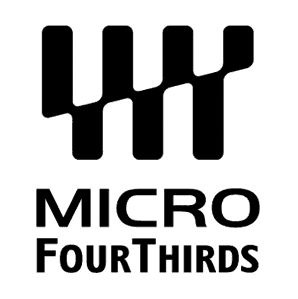 W
WThe Micro Four Thirds system is a standard released by Olympus and Panasonic in 2008, for the design and development of mirrorless interchangeable lens digital cameras, camcorders and lenses. Camera bodies are available from Blackmagic, DJI, JVC, Kodak, Olympus, Panasonic, Sharp, and Xiaomi. MFT lenses are produced by Cosina Voigtländer, DJI, Kowa, Kodak, Mitakon, Olympus, Panasonic, Samyang, Sharp, Sigma, SLR Magic, Tamron, Tokina, Veydra, and Xiaomi, amongst others.
 W
WThe Minolta A-mount camera system was a line of photographic equipment from Minolta introduced in 1985 with the world's first integrated autofocus system in the camera body with interchangeable lenses. The system used a lens mount called A-mount, with a flange focal distance 44.50 mm, one millimeter longer, 43.5 mm, than the previous SR mount from 1958. The new mount was wider, 49.7 mm vs 44.97 mm, than the older SR-mount and had a longer flange focal distance making old manual lenses incompatible with the new system. The mount is now used by Sony, who bought the SLR camera division from Konica Minolta, Konica and Minolta having merged a few years before.
 W
WThe Minolta CLE is a TTL-metering automatic exposure aperture-priority 35 mm rangefinder camera using Leica M lenses, introduced by Minolta in 1980.
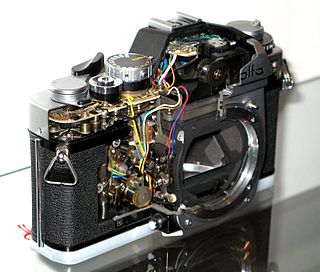 W
WThe Minolta SR-mount was the bayonet mounting system used in all 35 mm SLR cameras made by Minolta with interchangeable manual focusing lenses. Several iterations of the mounting were produced over the decades, and as a result, the mount itself was sometimes referred to by the name of the corresponding lens generation instead.
 W
WThe Minolta Vectis S-series comprises two APS system models of film SLR cameras made by Minolta, the flagship model Vectis S-1 and the Vectis S-100. The cameras feature a compact design, owing to the use of mirrors instead of prisms in the viewfinder.
 W
WThe Nikon 1-mount is a type of interchangeable lens mount developed by Nikon for its Nikon CX format mirrorless interchangeable-lens cameras. The 1-mount was first introduced on the Nikon 1 series in 2011, and features a bayonet mount.
 W
WThe Nikon F-mount is a type of interchangeable lens mount developed by Nikon for its 35mm format single-lens reflex cameras. The F-mount was first introduced on the Nikon F camera in 1958, and features a three-lug bayonet mount with a 44 mm throat and a flange to focal plane distance of 46.5 mm. The company continues, with the 2020 D6 model, to use variations of the same lens mount specification for its film and digital SLR cameras.
 W
WThe Nikon S-mount is a type of interchangeable lens mount used by a series of Nikon 35mm rangefinder cameras. The lenses were sold under the name Nikkor.
 W
WNikon Z-mount is an interchangeable lens mount developed by Nikon for its full-frame mirrorless digital cameras. In late 2018, Nikon released two cameras that use this mount, the Nikon Z 7 and the Nikon Z 6. In late 2019, Nikon announced their first APS-C sensor size Z-mount camera, the Nikon Z 50.
 W
WThe Samsung NX mini is a digital rangefinder-style interchangeable lens mirrorless camera announced by Samsung on March 19, 2014.
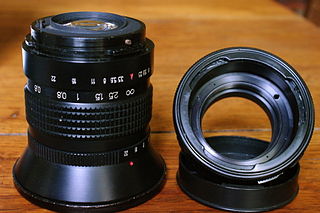 W
WThe Pentacon Six mount is a breech-lock bayonet lens mount originally used by several medium format single-lens reflex cameras from East Germany.
 W
WThe Pentax K-mount, sometimes referred to as the "PK-mount", is a bayonet lens mount standard for mounting interchangeable photographic lenses to 35 mm single-lens reflex (SLR) cameras. It was created by Pentax in 1975, and has since been used by all Pentax 35 mm and digital SLRs and also the MILC Pentax K-01. A number of other manufacturers have also produced many K-mount lenses and K-mount cameras.
 W
WThe S-mount is a standard lens mount used in various surveillance CCTV cameras and webcams. It uses a male metric M12 thread with 0.5 mm pitch on the lens and a corresponding female thread on the lens mount; thus an S-mount lens is sometimes called an "M12 lens". Because the lens mounts are usually attached directly to the PCB of the sensor, the standard is often called "board lens". The supported sensor formats range from the smallest 1/6-inch type to the largest 2/3-inch having an 11mm diagonal sensor. The lens mount is usually made of plastic and the lenses lack an iris control. S-mount lenses do not have a flange and therefore there is no fixed lens to sensor distance and they must be adjusted to focus.
 W
WThe Samsung NX mini is a digital rangefinder-style interchangeable lens mirrorless camera announced by Samsung on March 19, 2014.
 W
WSony α, is a camera system introduced on 5 June 2006. It uses and expands upon Konica Minolta camera technologies, including the Minolta AF SLR lens mount, whose assets were acquired by Sony after the end of Konica Minolta's photography operations in early 2006. Sony also has an 11.08% ownership stake in Japanese lens manufacturer Tamron, which is known to have partnered with Konica Minolta and Sony in the design and manufacture of many zoom lenses.
 W
WThe E-mount is a lens mount designed by Sony for their NEX and ILCE series of camcorders and mirrorless cameras. The E-mount supplements Sony's A-mount, allowing the company to develop more compact imaging devices while maintaining compatibility with 35mm sensors. E-mount achieves this by:Minimizing mechanical complexity, removing mechanical aperture and focus drive. Shortening the flange focal distance to 18 mm compared with earlier offerings from Sony which used 44.5 mm. Reducing the radius of the flange.
 W
WCineAlta cameras are a series of professional digital movie cameras produced by Sony that replicate many of the same features of 35mm film motion picture cameras.
 W
WSony α, is a camera system introduced on 5 June 2006. It uses and expands upon Konica Minolta camera technologies, including the Minolta AF SLR lens mount, whose assets were acquired by Sony after the end of Konica Minolta's photography operations in early 2006. Sony also has an 11.08% ownership stake in Japanese lens manufacturer Tamron, which is known to have partnered with Konica Minolta and Sony in the design and manufacture of many zoom lenses.
 W
WSony α, is a camera system introduced on 5 June 2006. It uses and expands upon Konica Minolta camera technologies, including the Minolta AF SLR lens mount, whose assets were acquired by Sony after the end of Konica Minolta's photography operations in early 2006. Sony also has an 11.08% ownership stake in Japanese lens manufacturer Tamron, which is known to have partnered with Konica Minolta and Sony in the design and manufacture of many zoom lenses.
 W
WThe E-mount is a lens mount designed by Sony for their NEX and ILCE series of camcorders and mirrorless cameras. The E-mount supplements Sony's A-mount, allowing the company to develop more compact imaging devices while maintaining compatibility with 35mm sensors. E-mount achieves this by:Minimizing mechanical complexity, removing mechanical aperture and focus drive. Shortening the flange focal distance to 18 mm compared with earlier offerings from Sony which used 44.5 mm. Reducing the radius of the flange.